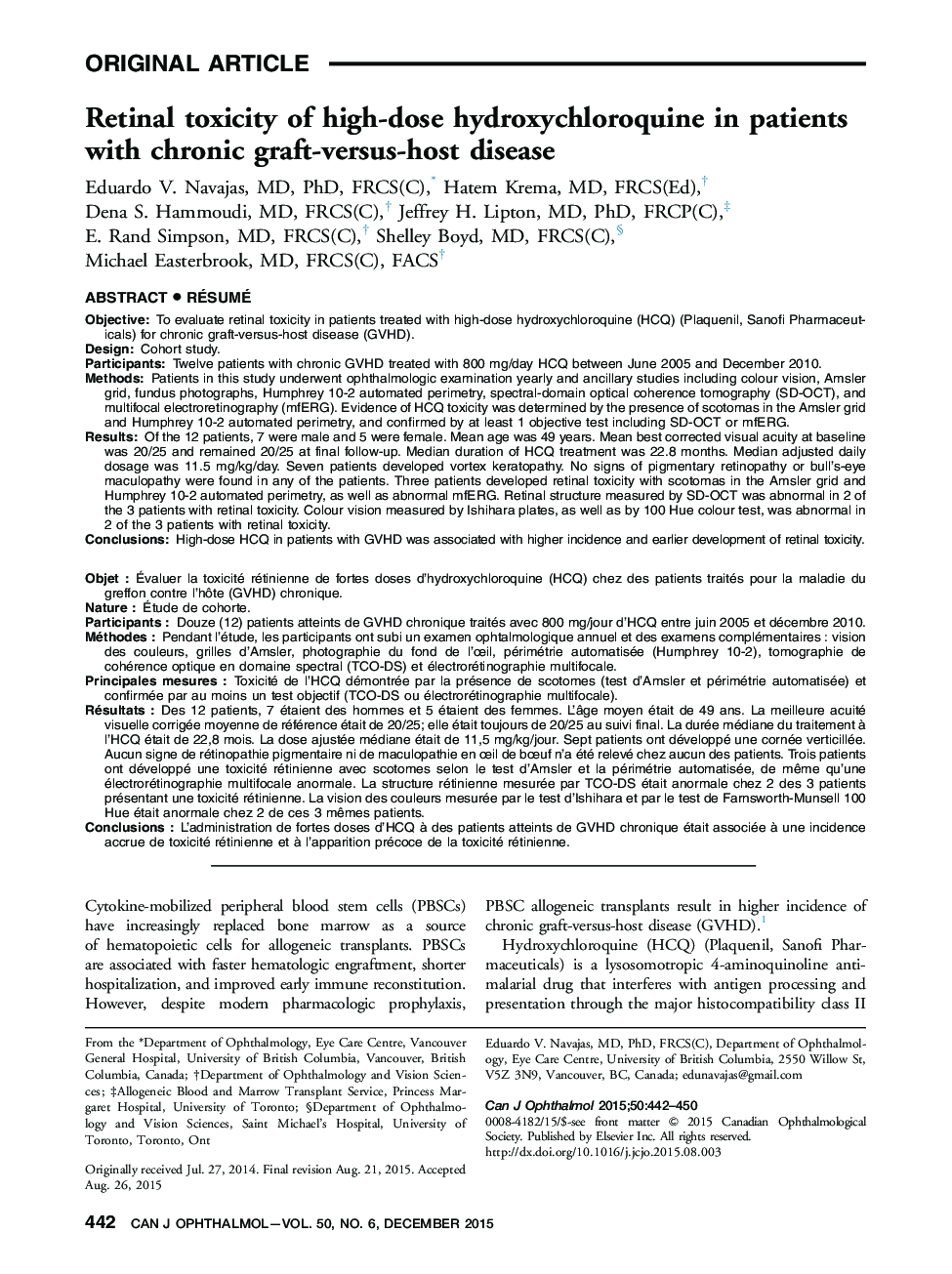| Article ID | Journal | Published Year | Pages | File Type |
|---|---|---|---|---|
| 4008993 | Canadian Journal of Ophthalmology / Journal Canadien d'Ophtalmologie | 2015 | 9 Pages |
ObjectiveTo evaluate retinal toxicity in patients treated with high-dose hydroxychloroquine (HCQ) (Plaquenil, Sanofi Pharmaceuticals) for chronic graft-versus-host disease (GVHD).DesignCohort study.ParticipantsTwelve patients with chronic GVHD treated with 800 mg/day HCQ between June 2005 and December 2010.MethodsPatients in this study underwent ophthalmologic examination yearly and ancillary studies including colour vision, Amsler grid, fundus photographs, Humphrey 10-2 automated perimetry, spectral-domain optical coherence tomography (SD-OCT), and multifocal electroretinography (mfERG). Evidence of HCQ toxicity was determined by the presence of scotomas in the Amsler grid and Humphrey 10-2 automated perimetry, and confirmed by at least 1 objective test including SD-OCT or mfERG.ResultsOf the 12 patients, 7 were male and 5 were female. Mean age was 49 years. Mean best corrected visual acuity at baseline was 20/25 and remained 20/25 at final follow-up. Median duration of HCQ treatment was 22.8 months. Median adjusted daily dosage was 11.5 mg/kg/day. Seven patients developed vortex keratopathy. No signs of pigmentary retinopathy or bull’s-eye maculopathy were found in any of the patients. Three patients developed retinal toxicity with scotomas in the Amsler grid and Humphrey 10-2 automated perimetry, as well as abnormal mfERG. Retinal structure measured by SD-OCT was abnormal in 2 of the 3 patients with retinal toxicity. Colour vision measured by Ishihara plates, as well as by 100 Hue colour test, was abnormal in 2 of the 3 patients with retinal toxicity.ConclusionsHigh-dose HCQ in patients with GVHD was associated with higher incidence and earlier development of retinal toxicity.
RésuméObjetÉvaluer la toxicité rétinienne de fortes doses d’hydroxychloroquine (HCQ) chez des patients traités pour la maladie du greffon contre l’hôte (GVHD) chronique.NatureÉtude de cohorte.ParticipantsDouze (12) patients atteints de GVHD chronique traités avec 800 mg/jour d’HCQ entre juin 2005 et décembre 2010.MéthodesPendant l’étude, les participants ont subi un examen ophtalmologique annuel et des examens complémentaires : vision des couleurs, grilles d’Amsler, photographie du fond de l’œil, périmétrie automatisée (Humphrey 10-2), tomographie de cohérence optique en domaine spectral (TCO-DS) et électrorétinographie multifocale.Principales mesuresToxicité de l’HCQ démontrée par la présence de scotomes (test d’Amsler et périmétrie automatisée) et confirmée par au moins un test objectif (TCO-DS ou électrorétinographie multifocale).RésultatsDes 12 patients, 7 étaient des hommes et 5 étaient des femmes. L’âge moyen était de 49 ans. La meilleure acuité visuelle corrigée moyenne de référence était de 20/25; elle était toujours de 20/25 au suivi final. La durée médiane du traitement à l’HCQ était de 22,8 mois. La dose ajustée médiane était de 11,5 mg/kg/jour. Sept patients ont développé une cornée verticillée. Aucun signe de rétinopathie pigmentaire ni de maculopathie en œil de bœuf n’a été relevé chez aucun des patients. Trois patients ont développé une toxicité rétinienne avec scotomes selon le test d’Amsler et la périmétrie automatisée, de même qu’une électrorétinographie multifocale anormale. La structure rétinienne mesurée par TCO-DS était anormale chez 2 des 3 patients présentant une toxicité rétinienne. La vision des couleurs mesurée par le test d’Ishihara et par le test de Farnsworth-Munsell 100 Hue était anormale chez 2 de ces 3 mêmes patients.ConclusionsL’administration de fortes doses d’HCQ à des patients atteints de GVHD chronique était associée à une incidence accrue de toxicité rétinienne et à l’apparition précoce de la toxicité rétinienne.
